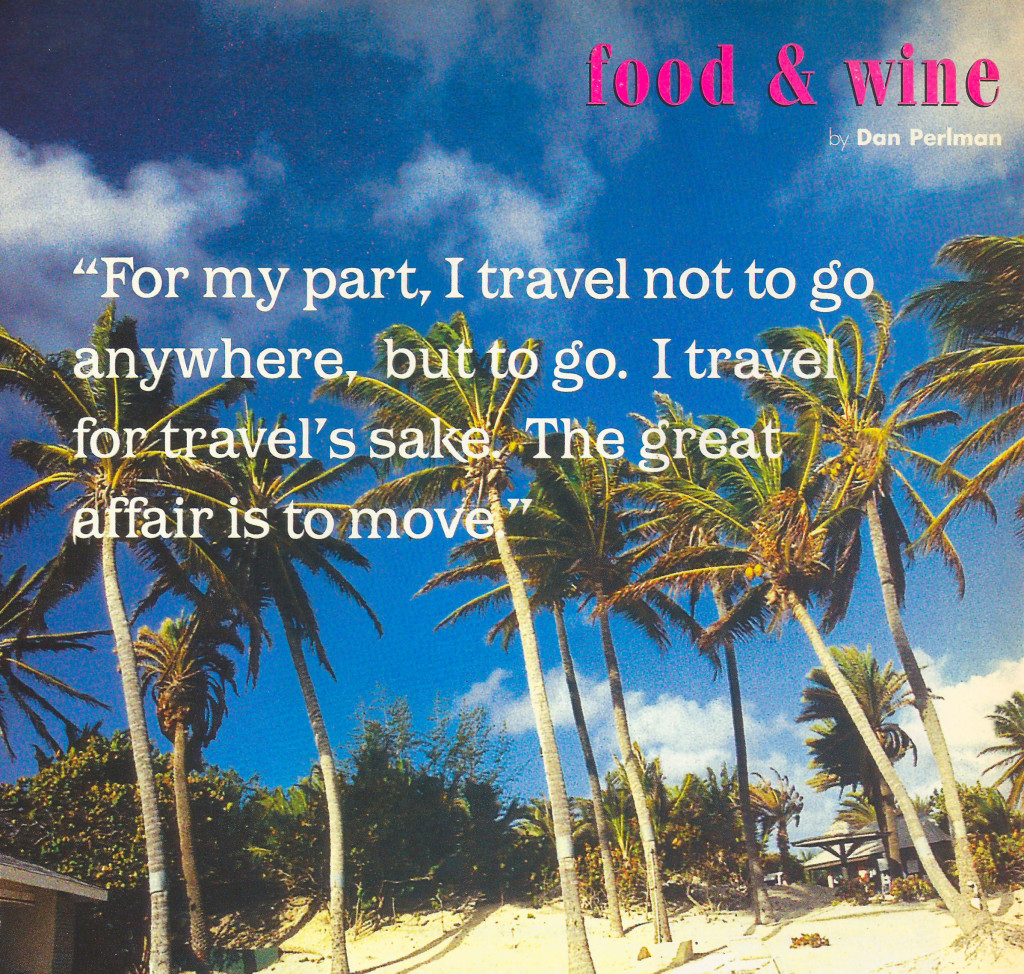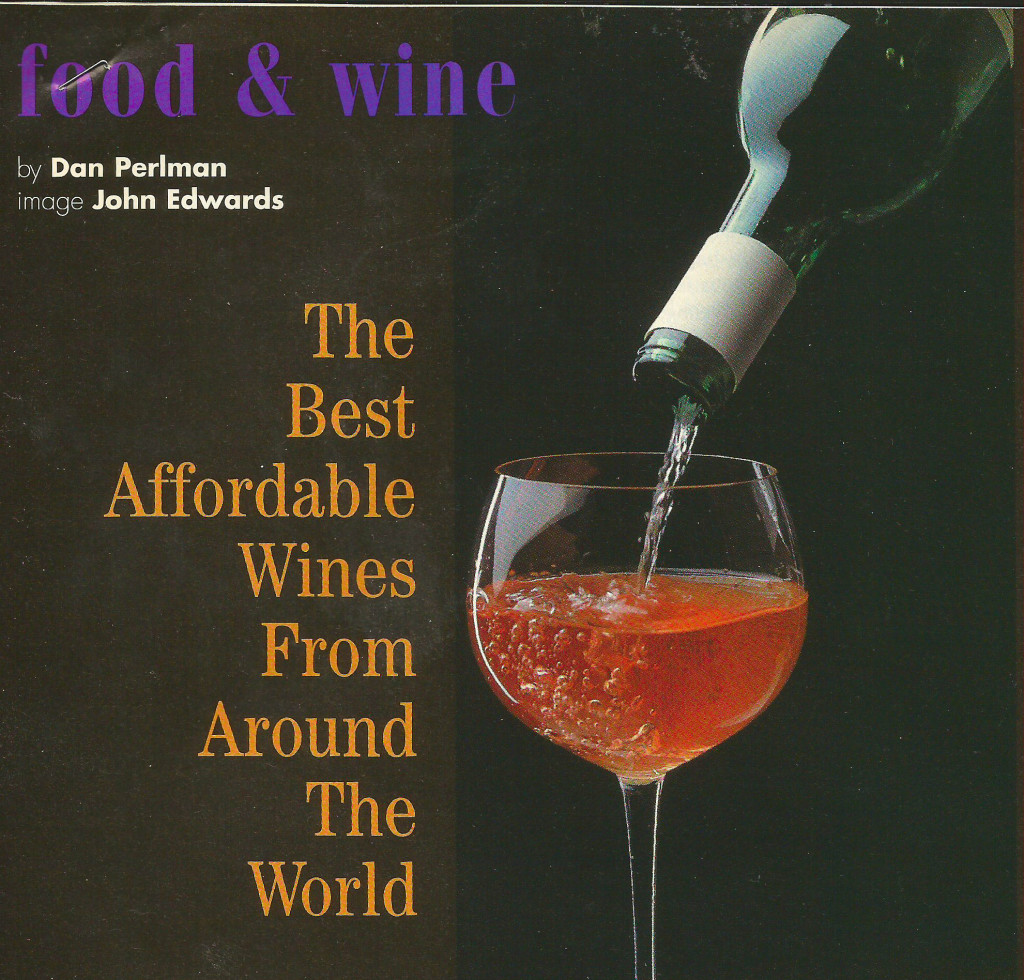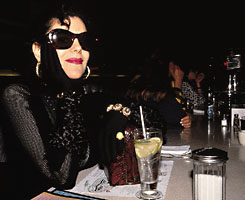Asia Pacific Travel Magazine
Fall 1993
Sydneyside for Sustenance
(Note: This article was accepted for publication, edited, laid-out, and then the magazine folded before printing… this is the edited version)
Swooping in over the South Pacific, I got my first good look at the Emerald City of Oz, Sydney. I knew I was in for high-rise office buildings and a lot of water, but I hadn’t predicted the bushland and white sand beaches. I always thought those were somewhere else in Australia. I’d also figured on a bunch of folk with Paul Hogan accents running around saying “G’day mate” and “Throw another shrimp on the bar-b.” I hadn’t figured on three and a half million people from every ethnic background on the planet, with accents to match, uttering those very words.
As a chef, my main goal in wandering through Sydney was the search for good food. I was unprepared for notable success, as Australia was rumored to be a country where, according to a local chef, the typical citizen is likely to be happy consuming “bangers and mash” three meals a day, every day. I’d heard that the traditional British based cuisine is so entrenched that the onslaught of Asian, North and South American, African, and other European cuisines don’t stand a chance.
Luckily, I found that with the help of some dedicated chefs and foodies, change has been in the air for the last decade or so. I’d like to say I had a chance to survey all the best that Sydney has to offer, but I didn’t even make it halfway through my list by the end of a month. Of course, the list kept growing as restaurateurs enthusiastically recommended each other’s cooking. These energetic and talented masters of pan and whisk put together some meals that made up for the endless hours I’d spent in the air enroute to dinner.
The Restaurant Manfredi
My local host insisted on taking me out to this romantic Ozzie-Italian brasserie hidden away in a back alley high above Darling Harbour. Stephanie Alexander, one of Australia’s most noted food writers had also recommended the place. Chef Stefano Manfredi came out to say hello and offered to whip up a special dinner for us. He and his family have been whipping up what may be the best Italian style food in the South Seas for almost eight years.
On his recommendation, our waiter opened a bottle of 1986 Plantagenet Cabernet Sauvignon that was rich with plum, cinnamon, and toasted oak flavors. We started our repast with a basket of fresh bread dipped in a glassy pool of olive oil and then moved on to opening courses of succulent seared Queensland scallops on a cradle of linguini and sun-dried tomatoes tossed with garlicky olive oil and, a local favorite, delicious yabbies (local crayfish) served with incredibly light spinach gnocchi in a pool of browned butter.
Next, we had savory grilled kingfish steaks perched atop sauted Chinese greens and accompanied by olive puree and a basil, parsley, garlic and olive oil salsa verde. This was followed by a plate of tender baby Illabo lambchops roasted with new potatoes and rosemary. Even better, a platter of roast pigeon with accompanying figs was stunning.
We finished off this culinary tour de force with a huge platter arrayed with outstanding baklava, an incredible pistachio mousse and slices of a delicious macadamia log, with side scoops of delicious pumpkin ice cream and tangy fruit sorbet. A striking presentation, especially with the scattering of caramelized figs and fresh berries.
The Restaurant, 88 Hackett Street, Ultimo, 281-2808. Dinner $60-70 (US$40-45).
The Bathers Pavilion
We met up one evening with a couple of friends down at the Balmoral Esplanade. Picture an attractive sandy beach and cove, the last rays of sun glittering off the rippling water, and a bather’s pavilion converted to a first class dining room situated squarely on the beach. The atmosphere inside is relaxed, and patrons sometimes climb through the windows from the beach, though we chose to enter by the door. Chef Genevieve Harris was not present on our visit. However, her second, Greg Smith, took exquisite care of us. On top of that, the restaurant’s sommelier, made recommendations perfect for every course.
He started us off with a bottle of 1990 Howard Park Riesling, with flavors of peaches and lime. Meanwhile the chef whipped up cold and hot appetizer platters. A salmon tartare, lightly dressed and served on toast was delightful, as were the timbale of roasted eggplant filled with goat cheese and the delicious tea-smoked river trout with caramelized onions, lovage and feta cheese. The hot selections provided us with two superb dishes, Yamba king prawns with “rag” pasta, tomatoes and olives and Western Australian sea scallops with sauted pine mushrooms on a parsnip rosti.
A bottle of 1990 Stafford Ridge Chardonnay, with a toasted vanilla bouquet and a hint of anise was served with the fish. A perfect match for savory John Dory filets, crusted lightly with pepper and served on top of crisp green beans and a mound of babaganoush and delectable Victorian salmon filets surrounded by charred peppers, crispy prosciutto and caramelized figs. The kitchen then served up platters piled high with slices of lamb and field mushrooms with a smooth puree of garlicky potatoes and a wonderful roast breast of guinea fowl nesting in spinach, garlic and almonds, while we sipped on a 1987 Mount Mary Cabernet Sauvignon, with its tart cherry and peppery air.
A fresh raspberry and clotted cream tart left my companions unimpressed, but I’ve always liked simple desserts. The chocolate and hazelnut semifreddo gave us our chocolate fix without going to excess. Cinnamon baklava with custard filling and a nectarine, roasted almond and candied orange rind salad was superb. The crowning selection, however, was coconut lace wafers with slices of fresh mango, whipped mascarpone cheese and a scoop of mango sorbet. And they didn’t miss with a small bottle of the delicious 1988 Petaluma Botrytis Riesling, an elixir of apricot and spice flavors.
The Bathers Pavilion, The Esplanade, Balmoral, 968-1133. Dinner $65-70 (US$45-50).
Rockpool
I’d already toured The Rocks, Sydney’s revamped and very touristy wharf area, and hadn’t been overly impressed. But, on recommendation, I decided to try this art deco establishment, serving up top-flight “new Australian” cuisine. Besides, Chef Neal Perry’s reputation as a master of fusing local flavors with touches of the Middle East and Asia couldn’t be ignored. None of my local friends were available, so I ventured out on my own.
A generous scoop of Sevruga caviar gracing a fresh Sydney Harbour oyster with a light squirt of lemon began an impressive evening. A small bottle of 1992 Grosset Polish Hill Riesling with lemon and grassy overtones was a nice match for a delicious dish of beautifully plated slices of steamed crayfish on a bed of braised leeks and lamb’s lettuce and a sauce of olive oil, golden raisins, toasted pinenuts and strips of dried mango. This was followed by delightful sea scallops, seared and served with hummus and fava beans, all drizzled with a garlicky olive oil. Although an interesting idea, the Spanner crab and bean sprout omelette floating in fish broth went limp on plate and palate.
The 1991 Pipers Brook Chardonnay was rich and buttery, with toasted oak and a hint of crisp apples. Rockpool is a place for fish, and the main course of herb encrusted salmon filet, pan-blackened and served with a red pepper sauce and savory roasted Szechuan eggplant was absolutely incredible.
Chef Perry’s signature dessert, a date tart filled with plump California dates baked in a custardy pastry cream just about did me in, until, sighing with contentment, he presented a second offering of caramelized nectarines layered with crisp waffles amidst a pool of caramel and vanilla bean sauce, with a scoop of nectarine ice cream at the side. I found room for more.
Rockpool, 109 George Street, The Rocks, 252-1888. Dinner $75-80 (US$50-55).
Riberries
It was, of course, necessary that we sample “native” cuisine in some fashion. Sydney is not currently host to an eatery that serves up first class witjuti grubs or grilled fruit bats, but it does have this bistro that specializes in using native Australian bush foods as ingredients in a dining experience not to be missed. Chef Jean-Paul Bruneteau greeted us as we sat down to the evening’s prix fixe selections. Riberries is a BYO kind of place, so we picked up a 1991 Wyndham Estate Pinot Noir at the bottle shop down the block.
It is admittedly not every day we get to sample a tasty emu liver paté, or a followup treat of smoked emu. Plates of chargrilled eggplant and zucchini rolled around roasted peppers with bush tomato relish and black olives were passed around to sighs of contentment. We sampled the main courses of delicious panfried Tasmanian Trumpeter fish with garlic potatoes, and a rack of lamb with native mint that was perfectly cooked and perfectly delectable.
Riberries themselves are used with abandon in the desserts. Tasting something like cloves, they made a mouth-watering match for the Chocolate Struth with Tasmanian cream and macadamia nut praline and the Caramel Cheesecake with homemade ice cream.
Riberries, 411 Bourke Street, Darlinghurst, 361-4929. Dinner $35-40 (US$25-30).
Angkor Wat
I’ve tried a lot of different Asian cuisines as I’ve travelled and tasted my way around, but Cambodian food had yet to pass my palate for review. In the course of our wanderings one day, we passed this tiny local establishment proudly announcing “Traditional Cambodian Cuisine From The Khmer Temple Palace.” With billing like that, who could pass it up?
Our appetizer selection ranged through a variety of dishes that appeared vaguely reminiscent of Thai, Vietnamese and Indonesian. We settled on Baksey Trong Ker, a roasted quail stuffed with minced pork, lily flowers, peanuts and vermicelli accompanied by a lime juice and spice dipping sauce, and Moan Slekteuy, chicken marinated with herbs and spices and steamed in bamboo leaves. Both were absolutely delicious and didn’t really remind us of Thai, Vietnamese or Indonesian cooking after all.
We followed with main courses of chicken stir-fried with lemongrass, onion, straw mushrooms and spices and a melange of prawns, mussels, scallops with their roe, and squid in a flaming brandy, cream, lemongrass and chili broth. Simply, outstanding.
Angkor Wat, 227 Oxford Street, Darlinghurst, 360-5500. Dinner $20-30 (US$15-20).
Darley Street Thai
I had heard stories and read articles about Sydney’s “Thai kitchen god,” David Thompson. So it seemed a necessity to make a trip to the depths of Newtown to sample his cuisine. (Since that time he’s moved his exceptional establishment to downtown Kings Cross, but I doubt his culinary prowess has suffered.) Thai cuisine is ubiquitous throughout Sydney, but his is reputed to be the best.
We settled in with a couple of Thai beers, and set out to sample from the remarkable selection of appetizers. One of my favorite Thai dishes has always been Laap Gai, or spicy chicken in lime, chilies and toasted rice, and it was no exception here. Crab Miang Mae Prow, a union of fresh crab meat, curry paste, kaffir lime leaves and roasted coconut wrapped in fresh betel leaves made our mouths water for more.
For main courses we sampled an unusual pineapple curry of those famed yabbies, which was deliciously sweet, if a bit messy. We also savored the flavors of the superb sea scallops in coconut milk and ginger.
Thai restaurants are not famous for desserts, at least in the U.S., but are worth saving room for here. We tried the bananas and white sticky rice grilled in banana leaves which was tasty, but the sumptuous golden syrup pudding with coconut cream was the clear winner of the evening.
Darley Street Thai, 28 Bayswater Road, Kings Cross, 358-6530. Dinner $40-45 (US$30-35).
Flavour of India
My host insisted that this establishment serves up the finest in Indian fare in Sydney. Although I didn’t sample the victuals from any other kitchens, I have to admit that this place serves up some great food.
We started off with Bhel Puri, a winning combination of potatoes with tomato, tamarind and coriander and a selection of spicy chutneys. We quickly followed up with Kankra Thal, a superb composition of crab, ginger, chili and onions mounded in potato skins, and a plate of Sabzi Patis, panfried vegetable patties coated with chickpea flour topped with almond sauce and beets.
The main courses menu included all the standards from curries to kormas, but our waitress recommended the Lamb Saag, a spicy hot blend of creamed spinach and sauted lamb and the Chicken Butter Masala, fillets of chicken breast broiled in the tandoor oven and served with a creamy butter sauce. Both were good, but I must admit, the appetizers were the winners here, especially accompanied by freshly baked pappadams and nan breads, and bowls of Raita, Dahl, Lime Pickles, and a spiced onion and tomato salad.
Flavour of India, 142 Glebe Point Road, Glebe, 692-0662. Dinner $20-25 (US$15-20).





 I never set out to be an Italophile. I never set out to focus my career on the world of Italian wine and food. Perhaps it was pre-saged by my first restaurant job in an Italian cafe back in my hometown of Ann Arbor, Michigan. But after that, most of my training tended to the Asian, or, as is now the current correct term in the field, Pacific Rim, cuisine. Somehow or other, a couple of years ago, I found myself back in an Italian restaurant.
I never set out to be an Italophile. I never set out to focus my career on the world of Italian wine and food. Perhaps it was pre-saged by my first restaurant job in an Italian cafe back in my hometown of Ann Arbor, Michigan. But after that, most of my training tended to the Asian, or, as is now the current correct term in the field, Pacific Rim, cuisine. Somehow or other, a couple of years ago, I found myself back in an Italian restaurant.


